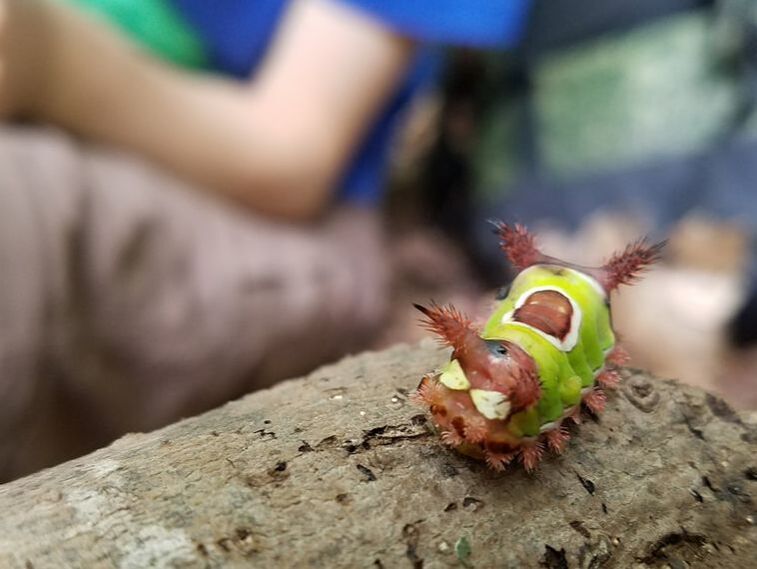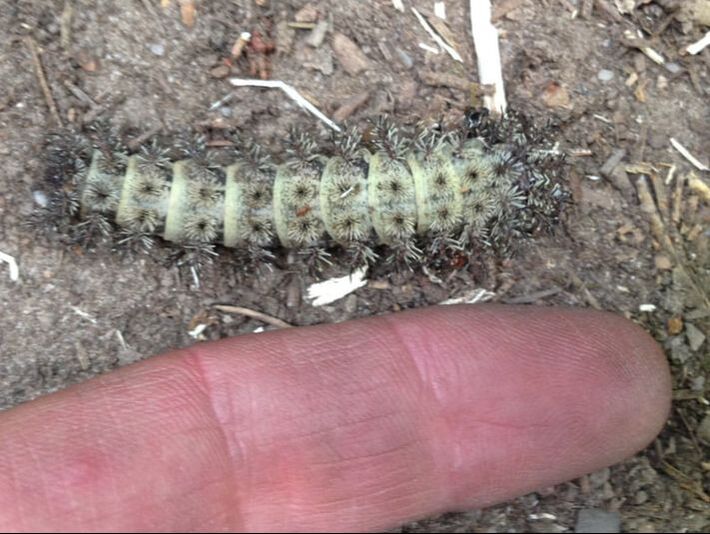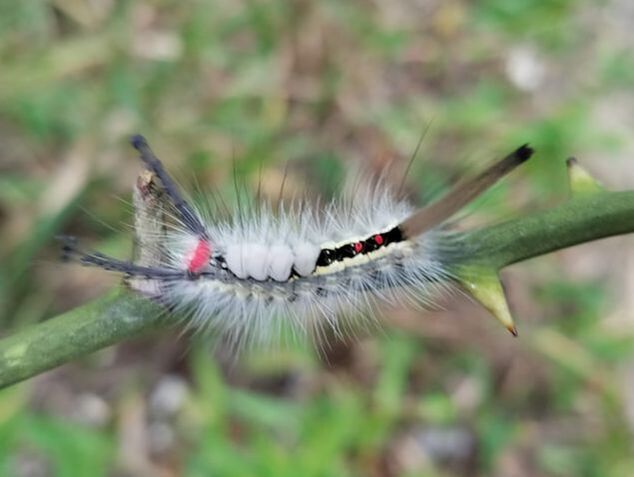Summer is a great time to find cool caterpillars. A few species in our area can sting or give you a rash though.
Read on to learn about the 3 species I've encountered, with links to more information.
1) Back to the saddleback again
At a summer camp some years back there was a boy who was prone to being obnoxiously loud, and rather careless. Fortunately, Mother Nature is a wonderful teacher!
As students were doing fire challenges near a stream we found some stinging saddleback caterpillars on some of the spicebushes that surrounded us.
When we moved on, I warned everyone to be alert while walking through the dense foliage, as there could be more in the area.
As we walked down a log, the muted calm of the forest was broken with an "Aaaaaaahhhhh!" - like in the famous Home Alone aftershave scene.
That same boy had gotten stung in the face by a saddleback on a leaf he brushed against!
He recovered just fine, and believe it or not, I think it was a good experience for him. He learned to be more cautious, and out of all the students there, he was the only one that returned the following year - for a week-long overnight program. He leveled up!
That's the only saddleback sting I've witnessed - a case of divine providence, arguably. Saddleback is the species of stinging caterpillar I see most in the DC area - but rarely at that.
Read on to learn about the 3 species I've encountered, with links to more information.
1) Back to the saddleback again
At a summer camp some years back there was a boy who was prone to being obnoxiously loud, and rather careless. Fortunately, Mother Nature is a wonderful teacher!
As students were doing fire challenges near a stream we found some stinging saddleback caterpillars on some of the spicebushes that surrounded us.
When we moved on, I warned everyone to be alert while walking through the dense foliage, as there could be more in the area.
As we walked down a log, the muted calm of the forest was broken with an "Aaaaaaahhhhh!" - like in the famous Home Alone aftershave scene.
That same boy had gotten stung in the face by a saddleback on a leaf he brushed against!
He recovered just fine, and believe it or not, I think it was a good experience for him. He learned to be more cautious, and out of all the students there, he was the only one that returned the following year - for a week-long overnight program. He leveled up!
That's the only saddleback sting I've witnessed - a case of divine providence, arguably. Saddleback is the species of stinging caterpillar I see most in the DC area - but rarely at that.
2) The buck moth stops here!
One of our favorite destinations in the region is Smoke Hole Canyon, WV - a great place for family camping, tubing and rock-climbing.
But I made the mistake of leaning back against the wrong oak tree there as I checked out the cliffs one summer. I felt something irritating on my back, like the sensation of scratchy wool in one spot.
Eventually, I discovered the culprit. Buck moth caterpillars are both camouflaged and very well armed with stinging spines.
When my daughter put her hand on one - scrambling up a steep slope in that same area, it was a very painful sting, but the pain soon faded and left no trace.
As for me - I still feel some itchiness on my back sometimes, even though a few years have passed.
One of our favorite destinations in the region is Smoke Hole Canyon, WV - a great place for family camping, tubing and rock-climbing.
But I made the mistake of leaning back against the wrong oak tree there as I checked out the cliffs one summer. I felt something irritating on my back, like the sensation of scratchy wool in one spot.
Eventually, I discovered the culprit. Buck moth caterpillars are both camouflaged and very well armed with stinging spines.
When my daughter put her hand on one - scrambling up a steep slope in that same area, it was a very painful sting, but the pain soon faded and left no trace.
As for me - I still feel some itchiness on my back sometimes, even though a few years have passed.
3) Tussock, tussock, tussock!
Various species of tussock moth caterpillars are much more common than any stinging ones in our area.
Last summer my wife May Joy felt something crawling on her and brushed off what turned out to be one of these guys.
When she brushed it, numerous hairs broke off and scattered on the moist tender skin just below her neck, triggering some very itchy hives.
So if you feel something crawling on you - ask someone else to remove it carefully by having it crawl onto a stick or leaf.
Various species of tussock moth caterpillars are much more common than any stinging ones in our area.
Last summer my wife May Joy felt something crawling on her and brushed off what turned out to be one of these guys.
When she brushed it, numerous hairs broke off and scattered on the moist tender skin just below her neck, triggering some very itchy hives.
So if you feel something crawling on you - ask someone else to remove it carefully by having it crawl onto a stick or leaf.
Closing thoughts:
From my brief research, the world's only potentially deadly caterpillar is found in Brazil - it looks like the buck moth caterpillar, but with longer spines.
The most painful local stinger is said to be the puss moth caterpillar. I don't know that I've found any yet, but they do live around here.
To learn about the puss moth, and other stinging caterpillars I've not described, check out this article.
Stinging caterpillars are generally rare in our region. This email summarizes literally all of the irritating encounters I've had.
But if you find one, expect there could be more of that species nearby and be wary.
And in general, I would use caution, especially in mid to late summer, when moving through dense foliage.
A sting to the neck could hypothetically cause a dangerous airway swelling emergency - although in my experience these stings do not swell as much as wasp stings. Climbers should also be careful on trees and rocks to avoid stings that might cause a fall.
Find a cool caterpillar? Have a good story? Share it on our Facebook page or in the comments below.
From my brief research, the world's only potentially deadly caterpillar is found in Brazil - it looks like the buck moth caterpillar, but with longer spines.
The most painful local stinger is said to be the puss moth caterpillar. I don't know that I've found any yet, but they do live around here.
To learn about the puss moth, and other stinging caterpillars I've not described, check out this article.
Stinging caterpillars are generally rare in our region. This email summarizes literally all of the irritating encounters I've had.
But if you find one, expect there could be more of that species nearby and be wary.
And in general, I would use caution, especially in mid to late summer, when moving through dense foliage.
A sting to the neck could hypothetically cause a dangerous airway swelling emergency - although in my experience these stings do not swell as much as wasp stings. Climbers should also be careful on trees and rocks to avoid stings that might cause a fall.
Find a cool caterpillar? Have a good story? Share it on our Facebook page or in the comments below.




 RSS Feed
RSS Feed
